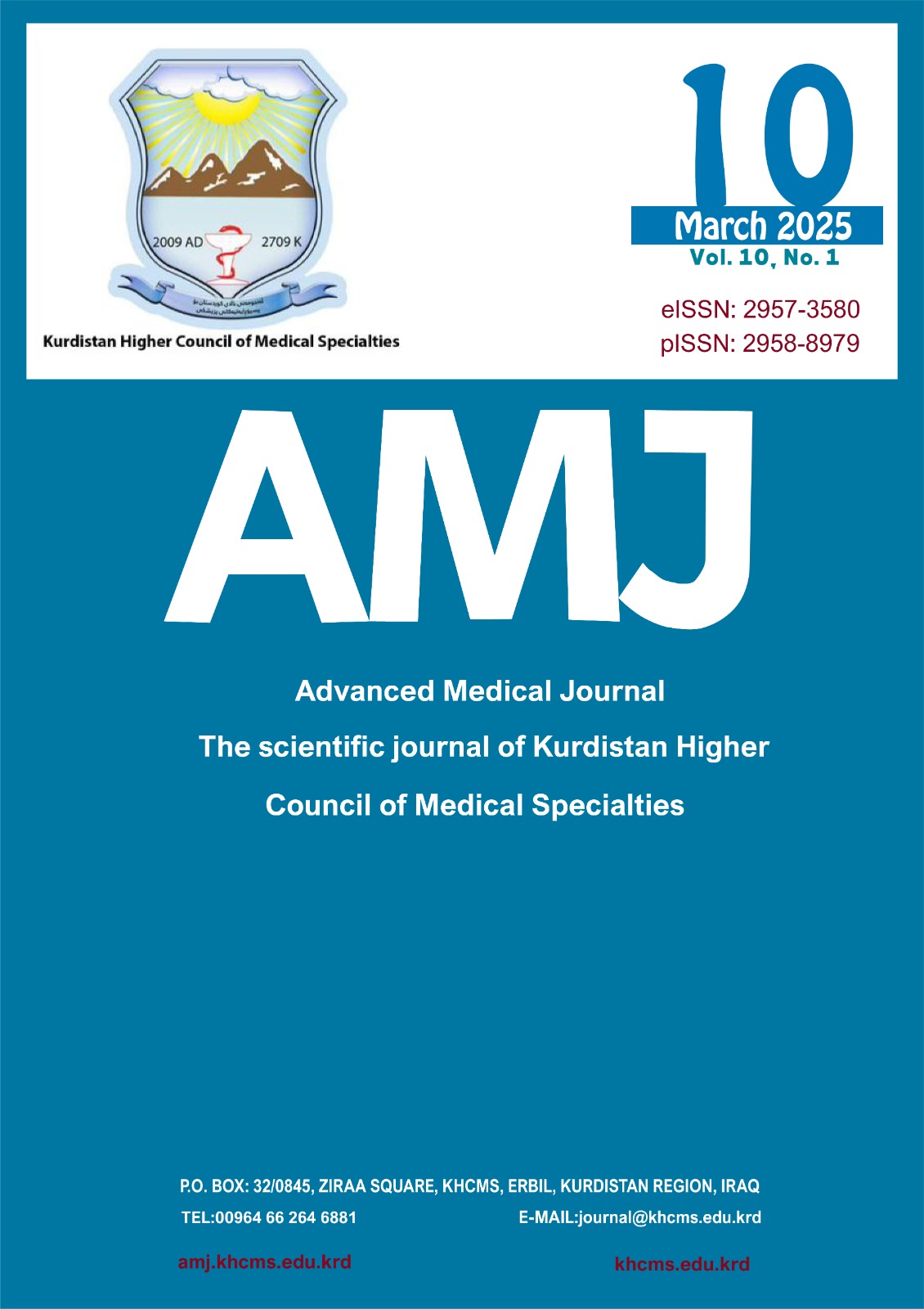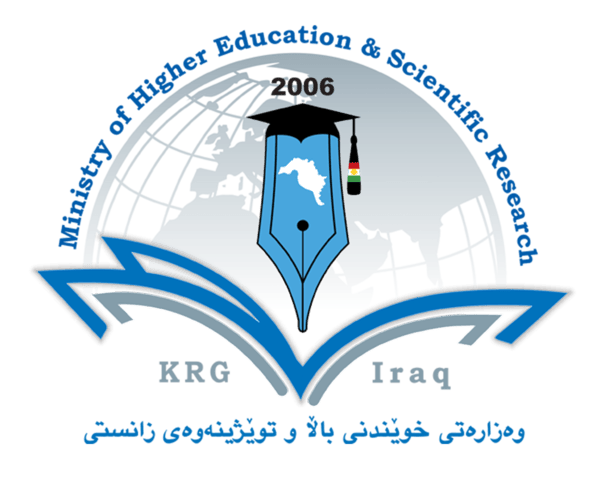Voice Changes After Thyroid Surgery; A Prospective Cohort Study
DOI:
https://doi.org/10.56056/amj.2025.331Keywords:
Objective voice changes, Post-thyroidectomy voice change, Recurrent laryngeal nerve, Subjective voice changeAbstract
Background and objectives: Voice changes (dysphonia) after thyroid surgery is an important complication that may have significant occupational, aesthetic, psychosocial and economic consequences on the patient. Two pairs of nerves supply the larynx, the recurrent laryngeal nerves and superior laryngeal nerves, which are susceptible to damage during thyroid surgery. The objectives of this study were to document the incidence, type, nature, severity, cause, and duration of voice complications after thyroid surgery.
Methods: The prospective cohort study included 100 patients who had thyroidectomy at the Sulaimani Teaching Hospital in Sulaimani City. The study carried out from January 2010 to December 2010. A special questionnaire Designed, which, included the following items: preoperative history (including age, sex, occupation, and professional voice user status), preoperative examination (encompassing local and general assessments), preoperative investigations check-up of vocal cords, intraoperative assessment by the anesthetist during extubation, and postoperative evaluations conducted by the researcher in the immediate, early, and late stages.
Results: The participant’s age range was 20-75 years, mean age 38.0 ± 10.5 years, with 88 women and 12 men. Immediately after the first postoperative week, voice changes were observed in 15.0% of the patients. Subjective voice changes (non neurogenic) account for 10.0% and objective changes account for 5.0% At three months of follow-up, Subjective voice changes were observed in 1.0% of the patients, with objective voice changes accounting for 4.0%. Finally, after six to 12 months, objective voice changes were observed in 2.0% of the patients, the result was not signifint statistically.
Conclusion: Objective voice change complaints require precise laryngeal nerve identification and protection durig surgery. These findings show that rigorous surgical procedures and thorough pre- and postoperative vocal examinations are needed to reduce risks and control long-term effects. Subjective change lesions were more prevalent than objective lesions.
Downloads
References
Mathieson L. Greene and Mathieson's The Voice and its Disorders, 6th Ed. 2001.
Reeve T and Thompson NW. Complications of thyroid surgery: how to avoid them, how to manage them, and observations on their possible effect on the whole patient. World J Surg 2000; 24: 971-975. DOI: 10.1007/s002680010160/
McIvor NP, Flint DJ, Gillibrand J, et al. Thyroid surgery and voice-related outcomes. Aust N Z J Surg 2000; 70: 179-183. DOI: 10.1046/j.1440-1622.2000. 01781.x/
Choi Y, Keum BR, Kim JE, et al. Early Assessment of Voice Problems in Post-Thyroidectomy Syndrome Using Cepstral Analysis. Diagnostics (Basel) 2024; 14 20240104. DOI: 10.3390/diagnostics14010111/
Ludwig B, Ludwig M, Dziekiewicz A, et al. Modern Surgical Techniques of Thyroidectomy and Advances in the Prevention and Treatment of Perioperative Complications. Cancers (Basel) 2023; 15 20230526. DOI: 10.3390/cancers15112931/
Minuto MN, Reina S, Monti E, et al. Morbidity following thyroid surgery: acceptable rates and how to manage complicated patients. J Endocrinol Invest 2019; 42: 1291-1297. 20190523. DOI: 10.1007/s40618-019-01064-z/
Jatzko GR, Lisborg PH, Müller MG, et al. Recurrent nerve palsy after thyroid operations--principal nerve identification and a literature review. Surgery 1994; 115: 139-144.
Henry BM, Sanna S, Graves MJ, et al. The Non-Recurrent Laryngeal Nerve: a meta-analysis and clinical considerations. PeerJ 2017; 5: e3012. 20170321. DOI: 10.7717/peerj.3012/
Simó R, Nixon IJ, Rovira A, et al. Immediate Intraoperative Repair of the Recurrent Laryngeal Nerve in Thyroid Surgery. The Laryngoscope 2021; 131: 1429-1435. DOI: https://doi.org/10.1002/lary.29204/
Steurer M, Passler C, Denk DM, et al. Advantages of Recurrent Laryngeal Nerve Identification in Thyroidectomy and Parathyroidectomy and the Importance of Preoperative and Postoperative Laryngoscopic Examination in More Than 1000 Nerves at Risk. The Laryngoscope 2002; 112: 124-133. DOI: https://doi.org/10.1097/00005537-200201000-00022/
Yumoto E, Minoda R, Hyodo M, et al. Causes of recurrent laryngeal nerve paralysis. Auris Nasus Larynx 2002; 29: 41-45. DOI: https://doi.org/10.1016/S0385-8146(01)00122-5/
Hayward NJ, Grodski S, Yeung M, et al. Recurrent laryngeal nerve injury in thyroid surgery: a review. ANZ Journal of Surgery 2013; 83: 15-21. DOI: https://doi.org/10.1111/j.1445-2197.2012.06247.x/
Liu XH, Yan J, Li N, et al. A comparative analysis of laryngeal nerve damage in patients with idiopathic vocal cord paralysis exhibiting different paralytic sides. Laryngoscope Investig Otolaryngol 2024; 9: e1205. 20240105. DOI: 10.1002/lio2.1205/
Zakaria HM, Al Awad NA, Al Kreedes AS, et al. Recurrent laryngeal nerve injury in thyroid surgery. Oman Med J 2011; 26: 34-38. DOI: 10.5001/omj.2011.09/
Bellantone R, Boscherini M, Lombardi CP, et al. Is the identification of the external branch of the superior laryngeal nerve mandatory in thyroid operation Results of a prospective randomized study. Surgery 2001; 130: 1055-1059. DOI: 10.1067/msy.2001.118375/
Jonas J and Bähr R. Neuromonitoring of the external branch of the superior laryngeal nerve during thyroid surgery. The American Journal of Surgery 2000; 179: 234-236. DOI: https://doi.org/10.1016/S0002-9610(00)00308-1/
Aluffi P, Policarpo M, Cherovac C, et al. post-thyroidectomy superior laryngeal nerve injury. European Archives of Oto-Rhino-Laryngology 2001; 258: 451-454. DOI: 10.1007/s004050100382/
Lee CY, Long KL, Eldridge RJ, et al. Preoperative laryngoscopy in thyroid surgery: Do patients' subjective voice complaints matter? Surgery 2014; 156: 1477-1482; discussion 1482-1473. 20141111. DOI: 10.1016/j.surg.2014.08.038/
Pagedar NA and Freeman JL. Identification of the external branch of the superior laryngeal nerve during thyroidectomy. Arch Otolaryngol Head Neck Surg 2009; 135: 360-362. DOI: 10.1001/archoto.2009.9/
Teshima M, Otsuki N, Morita N, et al. Postoperative hypoparathyroidism after total thyroidectomy for thyroid cancer. Auris Nasus Larynx 2018; 45: 1233-1238. 20180507. DOI: 10.1016/j.anl.2018.04.008/
Sataloff RT, Chowdhury F, Portnoy JE, et al. Surgical Techniques in Otolaryngology - Head & Neck Surgery: Laryngeal Surgery. Jaypee Brothers Medical Publishers Pvt. Limited, 2013.
Randolph GW and Kamani D. Intraoperative electrophysiologic monitoring of the recurrent laryngeal nerve during thyroid and parathyroid surgery: Experience with 1,381 nerves at risk. Laryngoscope 2017; 127: 280-286. 20160708. DOI: 10.1002/lary.26166/
Riddell V. Thyroidectomy: Prevention of bilateral recurrent nerve palsy, results of identification of the nerve over 23 consecutive years (1946-69) with a description of an additional safety measure. British Journal of Surgery 2005; 57: 1-11. DOI: 10.1002/bjs.1800570102/
Stojadinovic A, Shaha AR, Orlikoff RF, et al. Prospective functional voice assessment in patients undergoing thyroid surgery. Ann Surg 2002; 236: 823-832. DOI: 10.1097/00000658-200212000-00015/
Beka E and Gimm O. Voice Changes Without Laryngeal Nerve Alterations After Thyroidectomy: The Need For Prospective Trials - A Review Study. J Voice 2024; 38: 231-238. 20210814. DOI: 10.1016/j.jvoice.2021.07.012/
Mohammad R, Huh G, Cha W, et al. Recurrent Laryngeal Nerve Paralysis Following Thyroidectomy: Analysis of Factors Affecting Nerve Recovery. Laryngoscope 2022; 132: 1692-1696. 20220119. DOI: 10.1002/lary.30024/
Patwardhan N, Cataldo T and Braverman LE. Surgical management of the patient with papillary cancer. Surg Clin North Am 1995; 75: 449-464. DOI: 10.1016/s0039-6109(16)46633-8/
Liu B-g, Wang B and Zhang N-s. Clinical use of a drain incision placed below and laterial to the thyroidectomy incision. Chinese Journal of Cancer Research 2004; 16: 58-61. DOI: 10.1007/BF02974869/
Chiaghana C and Awoniyi C. Complications of Thyroid Surgery. In: Freeman BS and Berger JS (eds) Anesthesiology Core Review: Part Two Advanced Exam. New York, NY: McGraw-Hill Education, 2016.
Chiang FY, Wang LF, Huang YF, et al. Recurrent laryngeal nerve palsy after thyroidectomy with routine identification of the recurrent laryngeal nerve. Surgery 2005; 137: 342-347. DOI: 10.1016/j.surg.2004.09.008/
Haxer MJ, Guinn LW and Hogikyan ND. Use of Speech Recognition Software: A Vocal Endurance Test for the New Millennium Journal of Voice 2001; 15: 231-236. DOI: https://doi.org/10.1016/S0892-1997(01)00023-6/
Scheuller MC and Ellison D. Laryngeal mask anesthesia with intraoperative laryngoscopy for identification of the recurrent laryngeal nerve during thyroidectomy. Laryngoscope 2002; 112: 1594-1597. DOI: 10.1097/00005537-200209000-00011/
Jonas J and Bähr R. Neuromonitoring of the external branch of the superior laryngeal nerve during thyroid surgery. Am J Surg 2000; 179: 234-236. DOI: 10.1016/s0002-9610(00)00308-1/
Downloads
Published
Issue
Section
License
Copyright (c) 2025 Aqeed Abid Ali, Faruk Hasan Faraj

This work is licensed under a Creative Commons Attribution-NonCommercial-ShareAlike 4.0 International License.
The copyright on any article published in AMJ (The Scientific Journal of Kurdistan Higher Council of Medical Specialties )is retained by the author(s) in agreement with the Creative Commons Attribution Non-Commercial ShareAlike License (CC BY-NC-SA 4.0)














